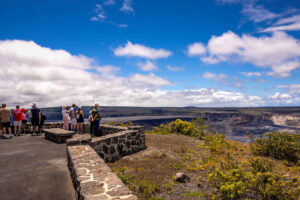Invasive species and earthquakes topped Big Island residents’ concerns during a community discussion last Monday about a planned update to Hawaii County’s Hazard Mitigation Plan.
As the county prepares for its fourth update to the 2005 document, members of the public have been invited to a pair of meetings to provide feedback about what they believe are the most pressing concerns facing the island.
At the first of those meetings, JaLeesa Tate, a representative from consulting firm Tetra Tech, presented a list of 13 potential threats to the Big Island and ranked them by level of greatest to least concern.
Those threats of highest concern included floods, windstorms, tropical cyclones, tsunamis and wildfires.
Disasters of medium concern included drought, storm surges, volcanic eruptions, landslides and a nebulous “human caused” disaster, while the threats of least concern included earthquakes, climate change and dam failure.
Tate said the Federal Emergency Management Agency requires climate change and dam failures to be included in hazard mitigation plans, regardless of how applicable they are to any given area.
The ranking was determined by a series of four factors, Tate explained: probability of occurrence, their potential impacts to human health or infrastructure, the county’s capability to adapt to the event, and the potential of changing future conditions such as climate change to exacerbate a disaster.
About a dozen residents in attendance were then asked to discuss their opinions about that ranking. Several suggested that some threats are understated and should be ranked higher.
In particular, many attendees wondered about the low ranking for earthquakes as a disaster of major concern, noting that the very seismically active island is constantly being rattled by tremors.
Tate said that the plan only takes into account earthquakes of magnitude 4.0 or greater, but added that it can be amended to note the high frequency of lower-magnitude quakes as a potential complicating factor.
Other attendees raised concerns about invasive species. The invasive albizia trees were brought up as an example, given that the brittle trees were the most significant source of damage in 2014 during Tropical Storm Iselle.
Others brought up the impacts of pests such as the coconut rhinoceros beetle — which stands to potentially devastate local palm populations — or even the parasitic rat lungworm.
“(Because of the rat lungworm,) KTA won’t sell produce from local farmers,” said one attendee, noting the parasite has weakened the county’s ability to be self-sustaining.
Tate said the plan will include some discussion about invasive species, but explained that it is primarily focused on “standalone” disasters that cause damage and disruption.
That said, the plan also will discuss the potential for cascading or compounding impacts, Tate said, such as the potential for a volcanic eruption to trigger an earthquake to trigger a tsunami to trigger a flood.
Tate said the county will develop an action plan and mitigation actions for each potential disaster, explaining that studies have indicated every dollar spent on mitigation returns six dollars saved on recovery.
“It helps escape the disaster/rebuild cycle, where a disaster destroys infrastructure, you rebuild it, and the next disaster destroys it and you rebuild it, and you never get to improve conditions,” Tate said.
She added the document also will be helpful for securing grant funding from FEMA, although she and many attendees commiserated about how difficult it often is to convince FEMA to pay up following a disaster.
Civil Defense Administrator Talmadge Magno said a more robust public comment and review period will begin in January and urged Big Island residents to submit feedback.
A public survey regarding the plan can be found at tinyurl.com/bdfp4kma.
A second public meeting took place at 5 p.m. Wednesday at the West Hawaii Civic Center.
Email Michael Brestovansky at mbrestovansky@hawaiitribune-herald.com.






